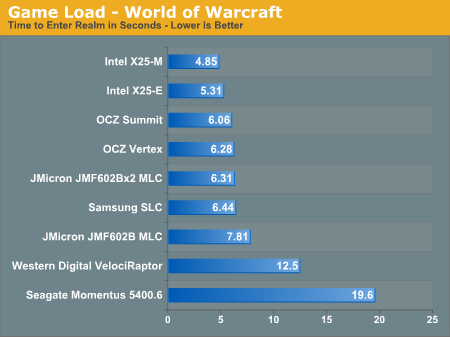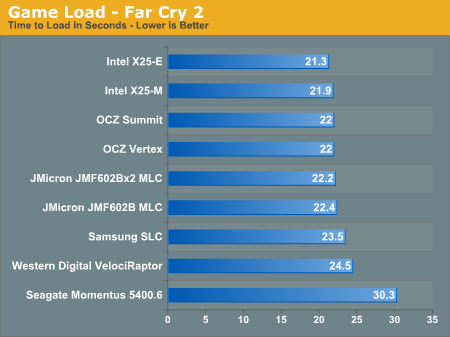The SSD Anthology: Understanding SSDs and New Drives from OCZ
by Anand Lal Shimpi on March 18, 2009 12:00 AM EST- Posted in
- Storage
Game Loading Performance
I chose two games to show both ends of the load time spectrum. The first test is World of Warcraft, I'm simply timing how long it takes from the character selection screen to a fully loaded scene in the realm I've chosen. Fully loaded means no more popping textures or waiting for anything else to load:

The Intel X25-M does the best here, even slightly outperforming the X25-E thanks to a more consumer-optimized firmware. The two OCZ drives occupy the third and fourth places, followed by the rest of the pack. No hard drive can keep up here thanks to the superior random read speed of a SSD.
The Far Cry 2 test is simply running the default benchmark and timing how long it takes to get from clicking launch to the loaded level:

While the SSDs take the cake here, the VelociRaptor isn't far behind. Once again the two Intel drives take the lead, followed by the two OCZ drives. The Vertex and the Summit tie in performance.










250 Comments
View All Comments
SkullOne - Wednesday, March 18, 2009 - link
Fantastic article. Definitely one of the best I've read in a long time. Incredibly informative. Everyone who reads this article is a little bit smarter afterwards.All the great information about SSDs aside, I think the best part though is how OCZ is willing to take blame for failure earlier and fix the problems. Companies like that are the ones who will get my money in the future especially when it is time for me to move from HDD to SSD.
Apache2009 - Wednesday, March 18, 2009 - link
i got one Vertex SSD. Why suspend will cause system halt ? My laptop is nVidia chipset and it is work fine with HDD. Somebody know it ?MarcHFR - Wednesday, March 18, 2009 - link
Hi,You wrote that there is spare-area on X25-M :
"Intel ships its X25-M with 80GB of MLC flash on it, but only 74.5GB is available to the user"
It's a mistake. 80 GB of Flash look like 74.5GB for the user because 80,000,000,000 bytes of flash is 74.5 Go for the user point of view (with 1 KB = 1024 byte).
You did'nt point out the other problem of the X25-M : LBA "optimisation". After doing a lot of I/O random write the speed in sequential write can get down to only 10 MB /s :/
Kary - Thursday, March 19, 2009 - link
The extra space would be invisible to the end user (it is used internally)Also, addressing is normally done in binary..as a result actual sizes are typically in binary in memory devices (flash, RAM...):
64gb
128gb
80 GB...not compatible with binary addressing
(though 48GB of a 128GB drive being used for this seems pretty high)
ssj4Gogeta - Wednesday, March 18, 2009 - link
Did you bother reading the article? He pointed out that you can get any SSD (NOT just Intel's) stuck into a situation when only a secure erase will help you out. The problem is not specific to Intel's SSD, and it doesn't occur during normal usage.MarcHFR - Wednesday, March 18, 2009 - link
The problem i've pointed out has nothing to do with the performance dregradation related to the write on a filled page, it's a performance degradation related to an LBA optimisation that is specific to Intel SSD.VaultDweller - Wednesday, March 18, 2009 - link
So where would Corsair's SSD fit into this mix? It uses a Samsung MLC controller... so would it be comparable to the OCZ Summit? I would expect not since the rated sequential speeds on the Corsair are tremendously lower than the Summit, but the Summit is the closest match in terms of the internals.kensiko - Wednesday, March 18, 2009 - link
No, OCZ Summit = newest Samsung controller. The Corsair use the previous controller, smaller performance.VaultDweller - Wednesday, March 18, 2009 - link
So what's the difference?The Summit is optimized for sequential performance at the cost of random I/O, as per the article. That is clearly not the case with the Corsair drive, so how does the Corsair hold up in terms of random I/O? That's what I'm interested in, since the sequential on the Corsair is "fast enough" if the random write performance is good.
jatypc - Wednesday, March 18, 2009 - link
A detailed description of how SSDs operate makes me wonder: Imagene hypothetically I have a SSD drive that is filled from more than 90% (e.g., 95%) and those 90% are read-only things (or almost read-only things such as exe and other application files). The remaining 10% is free or frequently written to (e.g., page/swap file). Then the use of drive results - from what I understood in the article - in very fast aging of those 10% of the SSD disk because the 90% are occupied by read-only stuff. If the disk in question has for instance 32GB, those 10% are 3.2 GB (e.g., a size of a usual swap file) and after writing it approx. 10000 times, the respective part of the disk would become dead. Being occupies by a swap file, this number of reads/writes can be achieved in one or two years... Am I right?